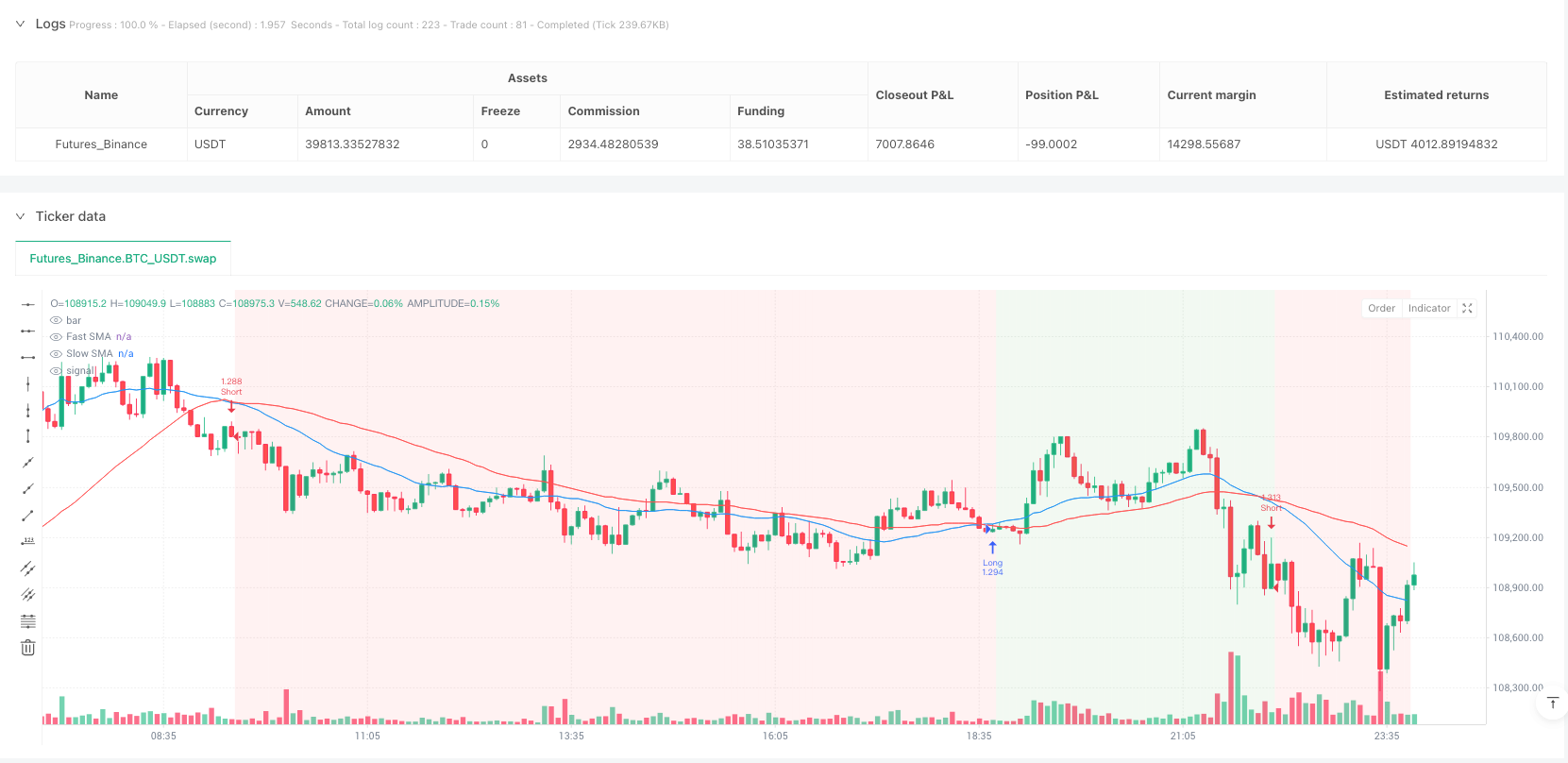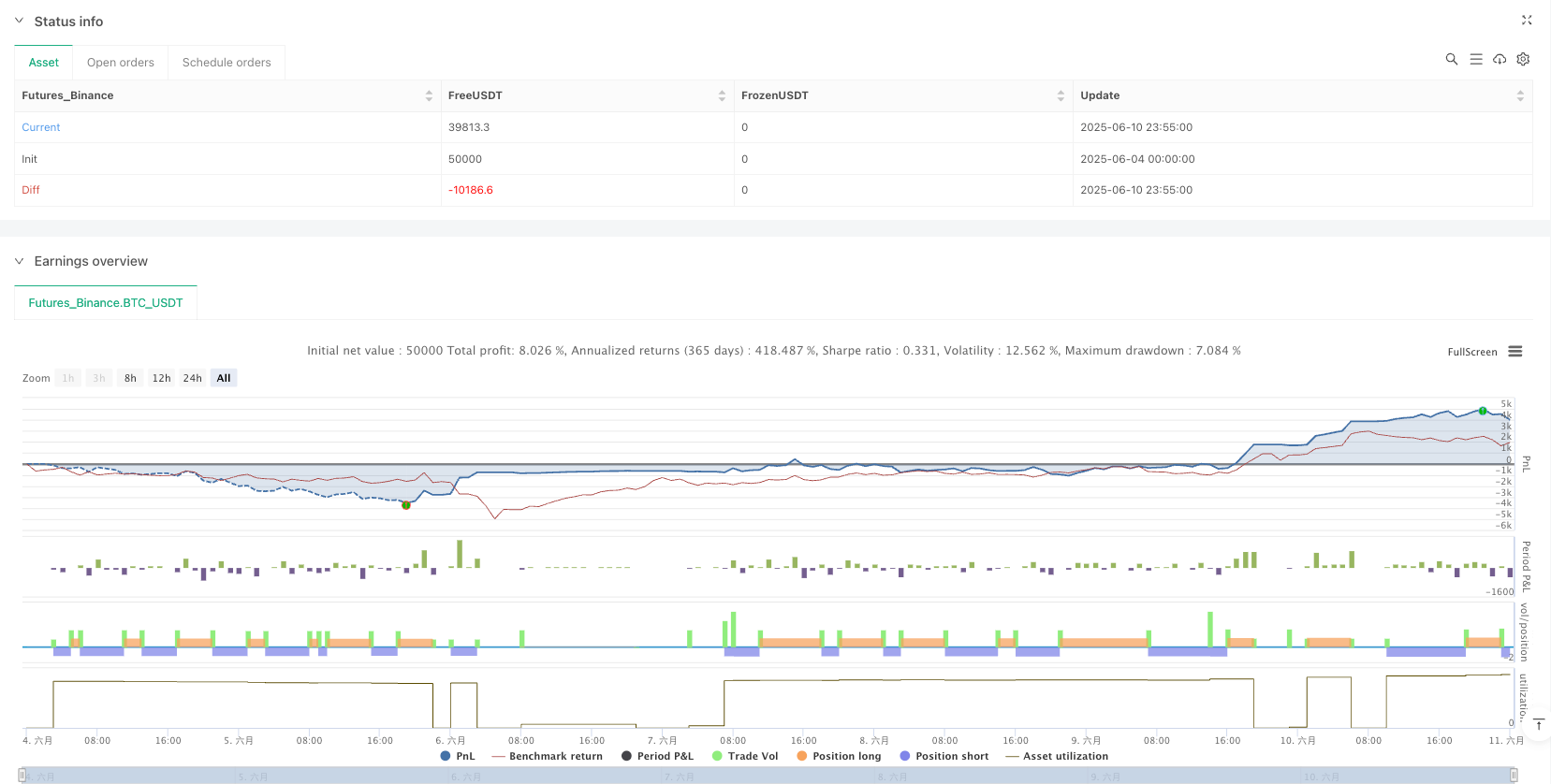双均线交叉趋势跟踪策略与高级风险管理系统
SMA CROSSOVER TRAILING STOP LOSS risk management POSITION SIZING Risk-Reward Ratio TAKE PROFIT STOP LOSS
创建日期:
2025-06-12 13:18:26
最后修改:
2025-06-12 13:18:26
复制:
1
点击次数:
302


策略概述
双均线交叉趋势跟踪策略是一种结合了技术分析与全面风险管理的量化交易系统。该策略核心利用快速简单移动平均线(Fast SMA)和慢速简单移动平均线(Slow SMA)的交叉信号来识别市场趋势变化,并通过多重风险控制机制确保资金安全。策略在Pine Script平台上实现,适用于多种交易品种的趋势跟踪交易。
策略原理
该策略基于两条简单移动平均线之间的交互关系进行交易决策:
信号生成机制:
- 做多信号: 当快速SMA(默认24周期)上穿慢速SMA(默认48周期)时
- 做空信号: 当快速SMA下穿慢速SMA时
- 平仓信号: 当出现相反的交叉信号时
执行时机控制: 策略在K线收盘时执行所有交易决策,避免前瞻性偏差(look-ahead bias),确保回测结果的可靠性和真实性。
资金管理系统:
- 每笔交易风险控制: 默认将每笔交易的最大风险限制在账户总资金的2.0%
- 仓位大小自动计算: 基于止损距离和风险金额动态调整,确保不超过预设风险限额
多层次风险控制:
- 固定止损(Stop Loss): 入场后立即设置固定百分比止损(默认0.8%),限制单笔亏损
- 获利目标(Take Profit): 基于风险回报比(默认2.0)自动计算,例如0.8%止损配合2.0风险回报比得出1.6%获利目标
- 高级追踪止损(Trailing Stop Loss):
- 激活条件: 当利润达到预设百分比(默认1.0%)时开始激活
- 追踪机制: 一旦激活,止损价将追踪最高价(做多)或最低价(做空),保持指定距离(默认0.5%)
- 安全保障: 确保追踪止损永不低于初始止损水平,在保护资金安全的同时允许利润继续增长
该策略通过均线交叉捕捉趋势,并使用全面的风险管理措施确保交易的安全性和可持续性。
策略优势
稳健的趋势识别机制:
- 双均线交叉系统作为经典的趋势跟踪指标,具有历史验证的有效性和稳定性
- 通过调整快慢均线周期,可适应不同市场环境和时间周期的趋势特性
精确的资金管理:
- 基于账户净值的动态风险分配,确保每笔交易风险始终保持在可控范围内
- 仓位大小根据实际止损距离自动调整,避免过度杠杆或仓位过小的问题
- 系统自带安全检查机制,防止在极端情况下的计算错误
多层次的风险防护:
- 固定止损提供基础保护,限制最大亏损幅度
- 基于风险回报比的获利目标设置,确保平均收益超过平均损失
- 高级追踪止损机制保护已实现利润,同时不影响趋势延续的潜在收益
交易执行的时序控制:
- 严格基于K线收盘价执行所有交易决策,避免前瞻性偏差
- 使用
process_orders_on_close=true参数确保订单处理符合真实交易环境 - 交易逻辑基于前一K线的信号计算,避免使用未来数据
自适应的追踪止损系统:
- 追踪止损仅在交易达到预设盈利水平后激活,避免过早触发
- 止损水平随价格变动自动调整,锁定部分利润的同时允许趋势继续发展
- 内置保护机制确保追踪止损不会低于初始止损水平,提供持续的风险保护
策略风险
趋势识别滞后性:
- 移动平均线本质上是滞后指标,可能在趋势转折点反应不够及时
- 在震荡市场中可能产生频繁的假信号,导致”锯齿效应”(Whipsaw)
- 缓解方法: 可考虑增加额外的过滤条件,如波动率指标或趋势强度确认
固定参数适应性问题:
- 默认的SMA周期(24和48)在不同市场和时间周期的有效性可能存在差异
- 止损和获利目标的固定百分比设置可能不适合所有波动率环境
- 缓解方法: 建议根据具体交易品种的特性和历史波动率调整参数,或引入自适应参数机制
追踪止损激活时机:
- 激活追踪止损的盈利水平(默认1.0%)设置过高可能导致错过锁定利润的机会
- 设置过低则可能过早触发,限制潜在利润
- 缓解方法: 根据目标品种的平均真实波幅(ATR)比例设置追踪止损参数,使其更加自适应
资金管理风险:
- 对于波动率极低的品种,固定百分比止损可能导致仓位过大
- 极端市场条件下(如跳空或闪崩)可能无法按预设止损价格执行
- 缓解方法: 考虑设置最大仓位限制,或基于波动率指标(如ATR)动态调整风险参数
技术实现局限性:
- 当止损百分比设置为零或负值时的备选逻辑可能导致意外风险
- 未考虑交易费用和滑点对策略实际表现的影响
- 缓解方法: 完善错误处理逻辑,增加更多安全检查,并在回测中纳入交易成本因素
策略优化方向
信号生成机制优化:
- 引入自适应均线周期: 根据市场波动率动态调整快慢均线周期,提高对不同市场环境的适应性
- 增加辅助确认指标: 结合相对强弱指数(RSI)、随机指标(Stochastic)或MACD等指标,过滤低质量信号
- 考虑价格结构分析: 整合支撑阻力、价格形态识别等因素,提高信号质量
风险管理系统增强:
- 波动率自适应止损: 基于ATR等波动率指标动态设置止损距离,而非固定百分比
- 分段追踪止损策略: 实现多级追踪止损,随着利润增加逐步收紧追踪距离
- 最大回撤控制: 增加基于账户最大回撤比例的风险调整机制,在不利市场环境下自动降低风险
入场优化:
- 趋势强度过滤: 仅在趋势强度达到一定阈值时才执行交易信号
- 波动率窗口筛选: 在合适的波动率环境下执行交易,避开过度波动或波动不足的市场
- 最佳执行价格: 研究信号生成后的最优入场时机和价格水平
回测与评估框架:
- 多时间周期一致性: 验证策略在不同时间周期的一致性和稳健性
- 敏感性分析: 全面测试各参数变化对策略表现的影响,找出最稳定的参数组合
- 蒙特卡洛模拟: 通过随机化交易结果,评估策略的概率分布和稳健性
技术实现提升:
- 完善错误处理: 增强边缘情况处理,确保在各种市场环境下策略稳定运行
- 增加性能指标监控: 实时跟踪关键性能指标,如夏普比率、最大回撤等
- 策略状态可视化: 改进图形界面,直观显示策略状态、持仓和风险水平
总结
双均线交叉趋势跟踪策略是一个将经典技术分析方法与现代风险管理理念相结合的完整交易系统。其核心优势在于简洁明确的趋势识别机制与多层次的风险控制体系,特别是其精细的资金管理和高级追踪止损机制为策略提供了良好的风险调整回报潜力。
然而,该策略也面临移动平均线固有的滞后性和参数适应性等挑战。通过引入自适应参数、增强信号过滤机制以及完善风险管理系统,策略性能有望得到进一步提升。
总体而言,这是一个结构完善、逻辑清晰的量化策略框架,适合作为中长期趋势跟踪系统的基础,尤其适用于具有明显趋势特性的市场。对于交易者而言,理解并掌握其风险管理理念比简单复制策略参数更为重要,这也是该策略最有价值的部分。
策略源码
/*backtest
start: 2025-06-04 00:00:00
end: 2025-06-11 00:00:00
period: 5m
basePeriod: 5m
exchanges: [{"eid":"Futures_Binance","currency":"BTC_USDT"}]
*/
//@version=5
strategy(title="Dual SMA Crossover Strategy", overlay=true, calc_on_every_tick=false, process_orders_on_close=true)
// --- Inputs ---
// SMA Lengths
fast_length = input.int(24, title="Fast SMA Length", minval=1)
slow_length = input.int(48, title="Slow SMA Length", minval=1)
// Risk Management
risk_per_trade_percent = input.float(2.0, title="Risk Per Trade (%)", minval=0.1, maxval=10.0, step=0.1) // % of equity to risk per trade
stop_loss_percent = input.float(0.8, title="Stop Loss (%)", minval=0.1, step=0.1) // % from entry price
risk_reward_ratio = input.float(2.0, title="Risk-Reward Ratio", minval=0.5, step=0.1) // 2.0 = 2R, 3.0 = 3R etc.
// Advanced Trailing Stop Loss
trailing_start_percent = input.float(1.0, title="Trailing Stop Start (%)", minval=0.1, step=0.1) // % profit to activate TSL
trailing_stop_percent = input.float(0.5, title="Trailing Stop Trail (%)", minval=0.1, step=0.1) // % to trail by once activated
// --- Calculations ---
// Calculate SMAs
fast_sma = ta.sma(close, fast_length)
slow_sma = ta.sma(close, slow_length)
// Plot SMAs on chart
plot(fast_sma, color=color.blue, title="Fast SMA")
plot(slow_sma, color=color.red, title="Slow SMA")
// Crossover conditions (calculated on previous bar to prevent look-ahead bias)
long_condition = ta.crossover(fast_sma[1], slow_sma[1])
short_condition = ta.crossunder(fast_sma[1], slow_sma[1])
// --- Money Management and Position Sizing ---
// Calculate account equity and risk amount
account_equity = strategy.initial_capital + strategy.netprofit
risk_amount = account_equity * (risk_per_trade_percent / 100)
// Calculate Stop Loss price based on entry and SL percentage
var float long_stop_price = na
var float short_stop_price = na
var float long_take_profit_price = na
var float short_take_profit_price = na
// --- Trailing Stop Loss Variables ---
var float trailing_long_activated_price = na // Price at which TSL is activated for long
var float trailing_short_activated_price = na // Price at which TSL is activated for short
var float current_trailing_stop_long = na
var float current_trailing_stop_short = na
var bool is_long_trailing_active = false
var bool is_short_trailing_active = false
// --- Strategy Entry and Exit Orders ---
if long_condition
// Reset TSL variables for a new entry
trailing_long_activated_price := na
current_trailing_stop_long := na
is_long_trailing_active := false
// Calculate SL, TP for long entry
long_stop_price := close * (1 - stop_loss_percent / 100) // SL below entry
long_take_profit_price := close * (1 + (stop_loss_percent * risk_reward_ratio) / 100) // TP above entry based on RRR
// Calculate position size for long entry
price_change_per_unit = close * (stop_loss_percent / 100)
if price_change_per_unit > 0
long_quantity = risk_amount / price_change_per_unit
strategy.entry("Long", strategy.long, qty=long_quantity, comment="Buy Signal")
else
strategy.entry("Long", strategy.long, comment="Buy Signal (Risk calculation skipped)") // Fallback if SL is 0 or negative
if short_condition
// Reset TSL variables for a new entry
trailing_short_activated_price := na
current_trailing_stop_short := na
is_short_trailing_active := false
// Calculate SL, TP for short entry
short_stop_price := close * (1 + stop_loss_percent / 100) // SL above entry
short_take_profit_price := close * (1 - (stop_loss_percent * risk_reward_ratio) / 100) // TP below entry based on RRR
// Calculate position size for short entry
price_change_per_unit = close * (stop_loss_percent / 100)
if price_change_per_unit > 0
short_quantity = risk_amount / price_change_per_unit
strategy.entry("Short", strategy.short, qty=short_quantity, comment="Sell Signal")
else
strategy.entry("Short", strategy.short, comment="Sell Signal (Risk calculation skipped)") // Fallback if SL is 0 or negative
// --- Stop Loss, Take Profit, Trailing Stop Logic ---
// Long position management
if strategy.position_size > 0 // We are in a long position
entry_price = strategy.opentrades.entry_price(0)
current_profit_percent = ((close - entry_price) / entry_price) * 100
// Initial SL and TP set at entry
strategy.exit("Exit Long", from_entry="Long", stop=long_stop_price, limit=long_take_profit_price, comment="TP/SL Long")
// Check for Trailing Stop activation
if not is_long_trailing_active and current_profit_percent >= trailing_start_percent
is_long_trailing_active := true
// Set initial trailing stop when activated
trailing_long_activated_price := high // Or close, depending on preference
current_trailing_stop_long := high * (1 - trailing_stop_percent / 100)
// If trailing stop is active, update it
if is_long_trailing_active
// Only move the trailing stop up (for long positions)
potential_new_stop = high * (1 - trailing_stop_percent / 100)
current_trailing_stop_long := math.max(current_trailing_stop_long, potential_new_stop)
// Ensure trailing stop is not below the initial long_stop_price
// This prevents the trailing stop from being less protective than the initial SL if the price drops after activation.
current_trailing_stop_long := math.max(current_trailing_stop_long, long_stop_price)
strategy.exit("Trailing Exit Long", from_entry="Long", stop=current_trailing_stop_long, comment="Trailing SL Long")
// Short position management
if strategy.position_size < 0 // We are in a short position
entry_price = strategy.opentrades.entry_price(0)
current_profit_percent = ((entry_price - close) / entry_price) * 100
// Initial SL and TP set at entry
strategy.exit("Exit Short", from_entry="Short", stop=short_stop_price, limit=short_take_profit_price, comment="TP/SL Short")
// Check for Trailing Stop activation
if not is_short_trailing_active and current_profit_percent >= trailing_start_percent
is_short_trailing_active := true
// Set initial trailing stop when activated
trailing_short_activated_price := low // Or close, depending on preference
current_trailing_stop_short := low * (1 + trailing_stop_percent / 100)
// If trailing stop is active, update it
if is_short_trailing_active
// Only move the trailing stop down (for short positions)
potential_new_stop = low * (1 + trailing_stop_percent / 100)
current_trailing_stop_short := math.min(current_trailing_stop_short, potential_new_stop)
// Ensure trailing stop is not above the initial short_stop_price
current_trailing_stop_short := math.min(current_trailing_stop_short, short_stop_price)
strategy.exit("Trailing Exit Short", from_entry="Short", stop=current_trailing_stop_short, comment="Trailing SL Short")
// Plot background color to indicate active position (optional)
bgcolor(strategy.position_size > 0 ? color.new(color.green, 90) : na, title="Long Position Background")
bgcolor(strategy.position_size < 0 ? color.new(color.red, 90) : na, title="Short Position Background")
相关推荐